How Do You Determine If You Have Grounds For A PCB Exposure Lawsuit?
- Last Updated: December 16th, 2025
Key Takeaways
To initiate a PCB exposure lawsuit, establish the source of contact with PCBs through contaminated food or industrial products.
Keep detailed medical records of health problems like cancer and thyroid issues after exposure to PCBs.
Seek advice from a lawyer skilled in environmental law to understand your legal options and rights regarding PCB contamination.
Overview of the PCB Exposure Lawsuit
Question: How do you determine if you have grounds for a PCB exposure lawsuit?
Answer: Grounds for a PCB exposure lawsuit typically revolve around proving exposure to these toxic chemicals, showing that this exposure resulted in serious health problems, and establishing that certain companies are responsible for releasing PCBs into your environment.
On this page, we’ll discuss this question in further depth, an overview of what PCB exposure is, health risks associated with PCB exposure, and much more.
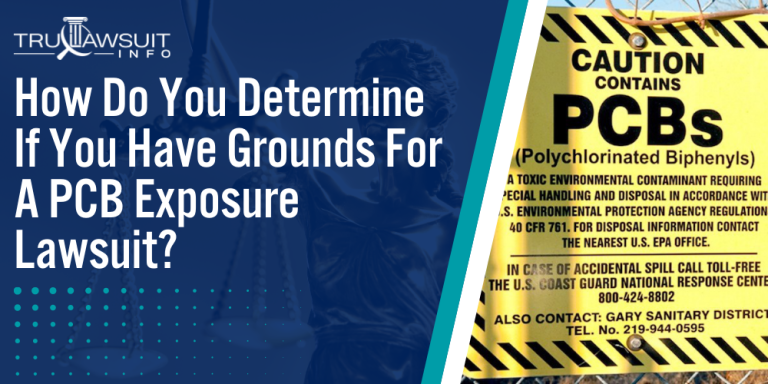
Intro To The PCB Exposure Lawsuit
The main routes of exposure to PCBs are through ingestion of contaminated foods, especially meat, fish, and poultry, and through inhalation or skin contact in occupational settings.
PCBs can also be present in drinking water.
If you or a loved one has experienced adverse health conditions after being exposed to PCB chemicals, you may be eligible to pursue compensation.
Contact TruLawsuit Info today using the chat on this page to receive an instant case evaluation.
PCBs and Their Health Effects
Understanding the impact of polychlorinated biphenyls (PCBs) on human health is crucial in assessing the need for legal action.
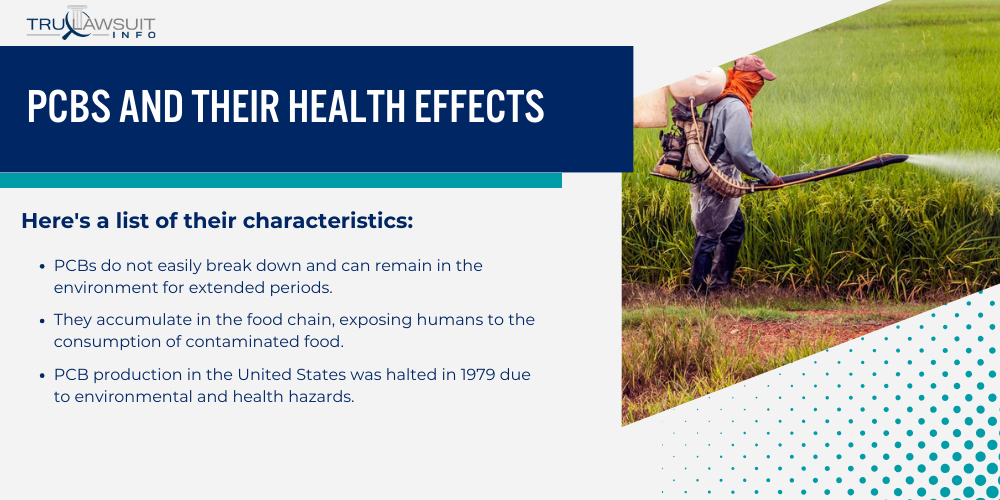
This section explores the environmental presence of PCBs and their association with various health concerns.
PCBs as Environmental Pollutants
PCBs have been recognized as toxic substances that persist in the environment, leading to widespread contamination.
These are a group of synthetic chemicals encompassing 209 different compounds, referred to as congeners.
Here’s a list of their characteristics:
- PCBs do not easily break down and can remain in the environment for extended periods.
- They accumulate in the food chain, exposing humans to the consumption of contaminated food.
- PCB production in the United States was halted in 1979 due to environmental and health hazards.
- Despite the ban, legacy PCBs continue to be a concern due to their presence in older electrical equipment and building materials, from where they can leach into the surroundings.
Health Concerns Linked to PCB Exposure
Being exposed to PCBs has been linked to various adverse health effects.
The National Toxicology Program classifies PCBs as probable human carcinogens, and research suggests multiple health risks:
- Cancer: Exposure to PCBs is associated with an increased risk of certain types of cancer, including liver cancer, brain cancer, and breast cancer.
- Immune System: PCB exposure can negatively impact the immune system, potentially making people more vulnerable to infections.
- Reproductive Issues: There is concern that PCBs can cause birth defects and other reproductive problems.
- Thyroid Hormones: These chemicals have been known to disrupt thyroid hormone balance, which is essential for metabolism and development.
It’s important for individuals who suspect health issues related to PCB exposure to be aware of these potential effects.
This awareness can be vital when considering a lawsuit for PCB exposure.
Determining Eligibility for a PCB Exposure Lawsuit
When considering a lawsuit for polychlorinated biphenyls (PCBs) exposure, it is crucial to understand the specific legal criteria and have proper documentation linking exposure to health problems.
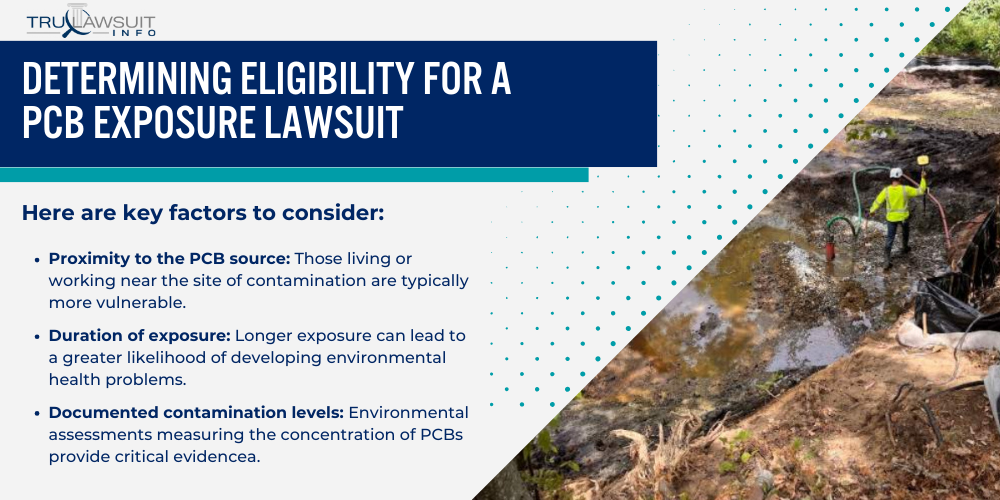
Legal Criteria for PCB Exposure Claims
Establishing a direct link between PCB exposure and health issues requires a clear chain of causation supported by robust evidence.
Here are key factors to consider:
- Proximity to the PCB source: Those living or working near the site of contamination are typically more vulnerable.
- Duration of exposure: Longer exposure can lead to a greater likelihood of developing environmental health problems.
- Documented contamination levels: Environmental assessments measuring the concentration of PCBs provide critical evidence.
- Presence of health conditions associated with PCBs: Only specific ailments linked to PCBs may be considered by courts.
- The precedent set by previous litigation: Prior successful lawsuits for similar circumstances can guide new claims.
- Animal studies indicating harm: Research on laboratory animals that demonstrates increased risk of cancer or other illnesses may support a case.
Documenting Exposure and Illness
Thorough documentation is a cornerstone of PCB exposure litigation.
Here are important forms of evidence to compile:
- Medical tests confirming illness: These medical documents connect health issues with PCB exposure.
- Records of duration and intensity of exposure: Employment records or resident histories can establish the length and potential dosage received.
- Testimonies of exposed workers or residents: Personal accounts provide a narrative weight to the scientific and medical evidence.
- Public health records: These can illustrate patterns of illness in communities near PCB contamination sites.
- Animal studies indicating a causative link: Scientific documents demonstrating how PCBs caused health issues in laboratory animals strengthen human claims.
- Correspondence with human services: Communications with agencies overseeing health can reveal awareness and potential negligence.
PCB Exposure Lawsuit: Sources of Contamination
Polychlorinated biphenyls (PCBs) are toxic chemicals that are widely used in various industrial and commercial applications.
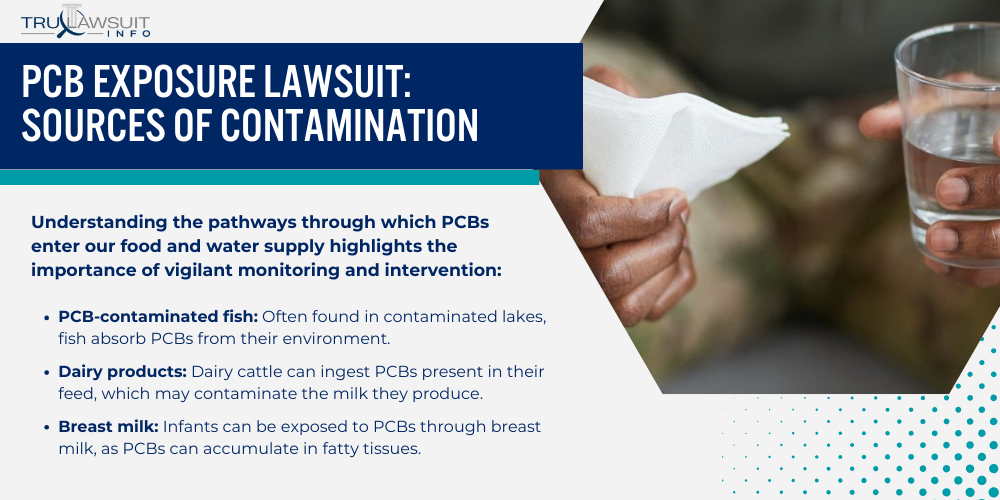
Understanding the common sources of PCB exposure is crucial when considering grounds for a lawsuit related to these hazards.
Food and Water Supply Contamination
Contamination in the food and water supply is a significant vector for PCB exposure.
PCBs have the ability to bioaccumulate, meaning their concentration can increase as they move up the food chain.
Understanding the pathways through which PCBs enter our food and water supply highlights the importance of vigilant monitoring and intervention:
- PCB-contaminated fish: Often found in contaminated lakes, fish absorb PCBs from their environment.
- Dairy products: Dairy cattle can ingest PCBs present in their feed, which may contaminate the milk they produce.
- Breast milk: Infants can be exposed to PCBs through breast milk, as PCBs can accumulate in fatty tissues.
- Eating contaminated fish: Regular consumption of foods sourced from contaminated areas poses a long-term risk.
Exposure in Occupational Settings
Work environments once regularly used PCB-containing materials, exposing workers to these harmful compounds through various means.
The risk of PCB exposure in occupational settings was historically significant due to the widespread use of PCB-containing equipment:
- Occupational settings where PCBs were actively used, such as in the manufacturing of electrical equipment.
- PCB transformers and capacitors: Individuals working with or around these electrical components were often at risk.
- Commercial PCB mixtures: Employees who handle a PCB mixture risk exposure during their daily tasks.
- Maintenance or disposal of PCB-containing equipment could facilitate exposure.
Household Exposure via Consumer Products
Household products containing PCBs have been sources of indoor environmental contamination.
Several common household items were once manufactured using PCBs, creating potential exposure risks within the home:
- Old fluorescent lighting fixtures: PCBs were used in the ballasts, potentially leading to exposure during use or disposal.
- Electrical transformers: Some homes may still contain these older transformers.
- Fluorescent lights: Aside from fixtures, the lights themselves might have exposed individuals to PCBs.
Legal Aspects of the PCB Exposure Lawsuit
The legal aspects of PCB litigation revolve around identifying negligence and liability and understanding the regulatory framework that governs PCB usage and disposal.
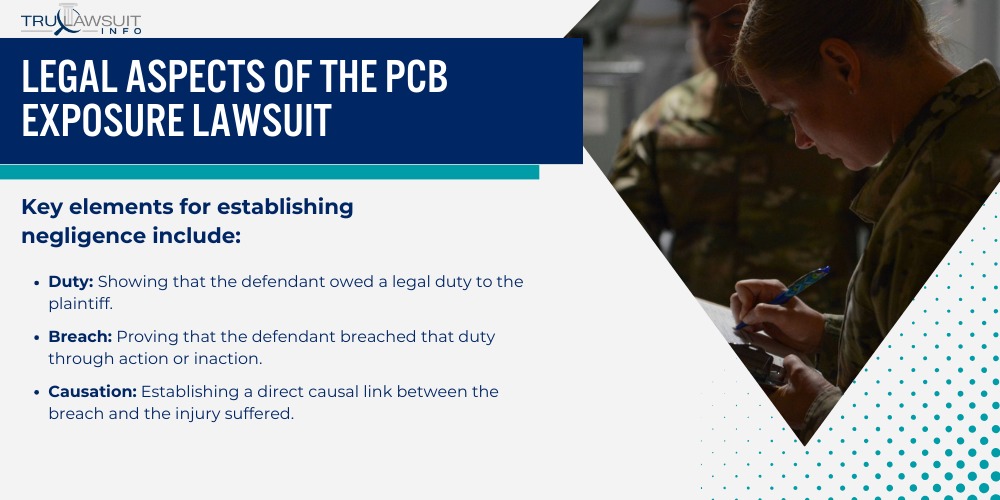
These two cornerstones form the base upon which persons affected by PCBs can substantiate their claims in a lawsuit.
Establishing Negligence and Liability
When considering a PCB exposure lawsuit, plaintiffs must demonstrate that the defendant was negligent in their duty of care and that this negligence led to harm.
In this context, negligence specifically refers to the failure to act with the foresight or care that reasonably prudent individuals or entities would exhibit under similar circumstances.
Key elements for establishing negligence include:
- Duty: Showing that the defendant owed a legal duty to the plaintiff.
- Breach: Proving that the defendant breached that duty through action or inaction.
- Causation: Establishing a direct causal link between the breach and the injury suffered.
- Damages: Documenting the actual damages that resulted from the exposure.
In cases of PCB exposure, the presence of PCBs in body fat, serum PCB levels, or environments such as contaminated lakes and hazardous waste sites can be crucial in demonstrating harm.
Additionally, the improper disposal of electrical devices and fluorescent lighting fixtures that contain PCBs can be cited as evidence of negligence.
Regulations Governing PCB Usage and Disposal
Federal laws play a significant role in governing PCB usage and disposal.
Understanding these regulations is essential for framing the context of liability in PCB litigation.
The primary regulatory points include:
- Toxic Substances Control Act (TSCA): Outlines PCB prohibitions and requirements for use, disposal, and storage.
- Resource Conservation and Recovery Act (RCRA): Governs the disposal of toxic wastes, including PCBs.
- Clean Water Act: Addresses the contamination of water sources, such as lakes where PCBs can accumulate.
- Comprehensive Environmental Response, Compensation, and Liability Act (CERCLA): This act establishes a framework for cleaning up hazardous waste sites and holds responsible parties liable for remediation.
PCB Exposure: Contamination Risk Factors
Polychlorinated biphenyls (PCBs) are environmental contaminants with the potential to cause serious health issues.
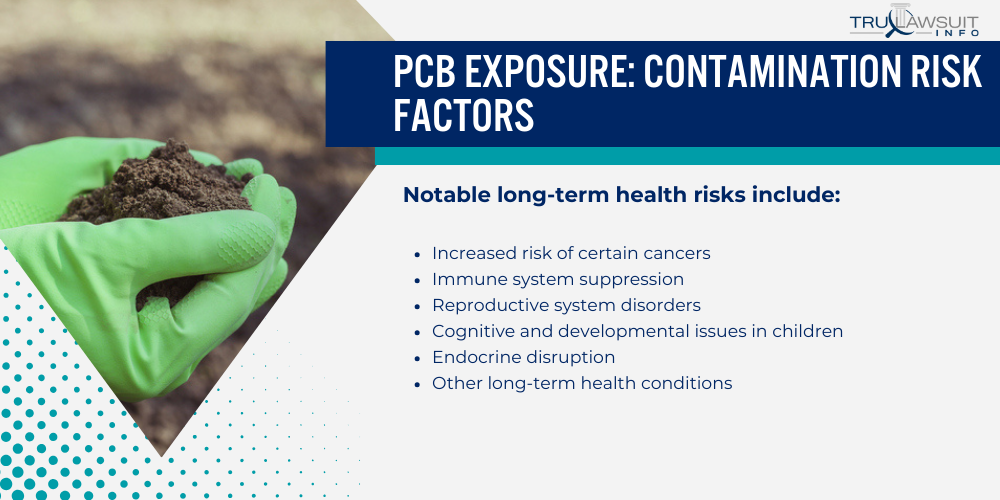
This section focuses on identifying the risk factors associated with PCB exposure and the populations that are particularly vulnerable.
Long-Term Health Risks of PCB Accumulation
PCBs can accumulate in the fatty tissues of living organisms, leading to long-term health risks.
One studied effect of PCB exposure is a potential alteration in women’s menstrual cycle length, which indicates a hormone-disruptive action.
In addition, consumption of contaminated food could lead to higher PCB congener levels in one’s system, with certain congeners being more toxic than others.
Notable long-term health risks include:
- Increased risk of certain cancers
- Immune system suppression
- Reproductive system disorders
- Cognitive and developmental issues in children
- Endocrine disruption
Vulnerable Populations and PCB Toxicity
Certain populations are more susceptible to the toxic effects of PCBs due to factors like diet, occupation, and location.
For instance, individuals living near former manufacturing sites may experience higher PCB exposures.
Particularly vulnerable groups comprise:
- Populations reliant on rice oil consumption, as historically seen in outbreaks of PCB poisoning
- Communities subsisting on fish from contaminated water bodies, escalating food chain biomagnification
- Workers in industries dealing with PCB manufacturing or disposal
- Subgroups with pre-existing health conditions that could be exacerbated by PCB accumulation or interaction with other chemicals
PCB Exposure Monitoring and Prevention
To effectively manage the risks associated with PCB exposure, precise monitoring and proactive prevention strategies are indispensable.
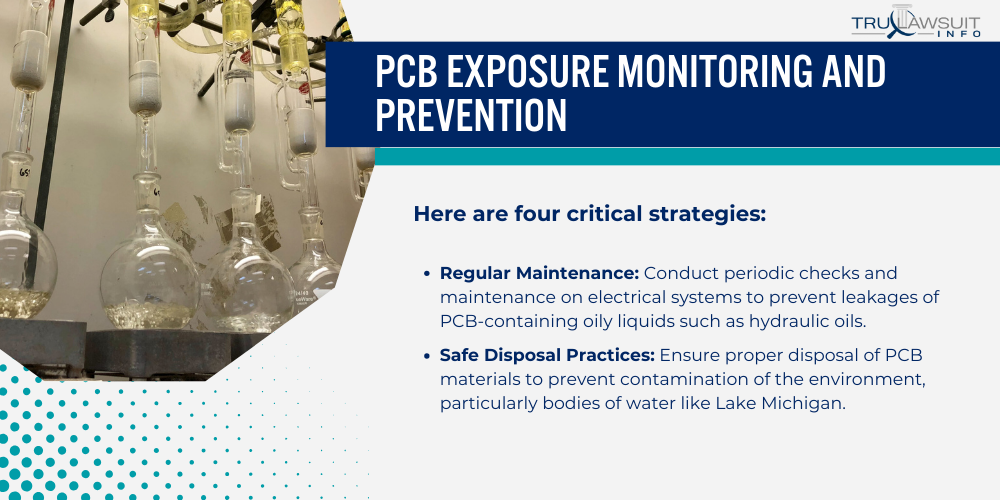
Addressing PCB-contaminated waters and occupational exposure is crucial, considering PCBs can bind strongly to environmental surfaces over long periods.
Strategies for Reducing PCB Exposures
He or she can implement several key measures to mitigate the risks associated with PCB exposure.
Here are four critical strategies:
- Regular Maintenance: Conduct periodic checks and maintenance on electrical systems to prevent leakages of PCB-containing oily liquids such as hydraulic oils.
- Safe Disposal Practices: Ensure proper disposal of PCB materials to prevent contamination of the environment, particularly bodies of water like Lake Michigan.
- Occupational Safety Measures: For industries with potential occupational carcinogen exposure, employers should provide protective gear and training to minimize risks.
- Legislative Compliance: Adherence to regulations laid out by agencies like the International Agency for Research on Cancer ensures that PCB handling practices meet safety standards.
Screening and Testing for PCBs in the Environment
The process of screening and testing the environment and food sources is integral to stopping the spread of PCB contamination.
These points highlight the objective:
- Environmental Testing: Screening soil, sediment, and water bodies for PCBs to proactively identify contamination events.
- Fish Consumption Advisories: Issuing advisories based on PCB levels in fish to inform safe fish consumption practices.
- Disease Registry Programs: Programs like a disease registry can track health outcomes potentially associated with PCB exposure, especially in areas where historic PCBs occurred.
- Public Health Campaigns: Educating the community on the dangers of PCBs and the importance of preventing exposure, including risks of lower birth weight and toxic responses.
Frequently Asked Questions
-
To file a PCB exposure lawsuit, plaintiffs must demonstrate that they were exposed to PCBs and that this exposure led to verifiable injuries.
It is crucial to prove that the defendant had a duty to prevent exposure and failed to meet this duty.
-
Health conditions commonly linked with PCB exposure include cancers such as melanoma and liver cancer, immune system and reproductive system disorders, and developmental problems when exposure occurs during pregnancy.
-
The statute of limitations for filing a PCB lawsuit can vary by jurisdiction, but it often begins on the date the plaintiff discovers or should have discovered the injury related to PCB exposure.
-
The required evidence typically encompasses medical records proving the health conditions, documentation of PCB presence and exposure levels, and expert witness testimony to establish a causal link between exposure and the injury.
-
Yes, there are precedents such as the case of Monsanto, PCBs, and the creation of a “world-wide ecological problem”.
These highlight the complexity of proving PCB-related damage and the need for comprehensive evidence of harm and causation.

Attorney Jessie Paluch, founder of TruLawsuit Info, has over 25 years of experience as a personal injury and mass tort attorney, and previously worked as an international tax attorney at Deloitte. Jessie collaborates with attorneys nationwide — enabling her to share reliable, up-to-date legal information with our readers.
Legally Reviewed
This article has been written and reviewed for legal accuracy and clarity by the team of writers and legal experts at TruLawsuit Info and is as accurate as possible. This content should not be taken as legal advice from an attorney. If you would like to learn more about our owner and experienced injury lawyer, Jessie Paluch, you can do so here.
Fact-Checked
TruLawsuit Info does everything possible to make sure the information in this article is up to date and accurate. If you need specific legal advice about your case, contact our team by using the chat on the bottom of this page. This article should not be taken as advice from an attorney.
You can learn more about the PCB Exposure Lawsuit by visiting any of our pages listed below:
Here, at Tru Lawsuit Info, we’re committed to helping victims get the justice they deserve.
To do this, we actively work to connect them with attorneys who are experts in litigating cases similar to theirs.
Table of Contents
Tru Lawsuit Info is a reliable source of information about issues that may affect your health and safety, such as faulty products, data breaches, and environmental hazards.
Our team of experienced writers collaborates with medical professionals, lawyers, and advocates to produce informative articles, guides, and other resources that raise awareness of these topics.
Our thorough research provides consumers with access to reliable information and updates on lawsuits happening around the country. We also can connect consumers with attorneys if they need assistance.
Here, at Tru Lawsuit Info, we’re committed to helping victims get the justice they deserve.
To do this, we actively work to connect them with attorneys who are experts in litigating cases similar to theirs.
